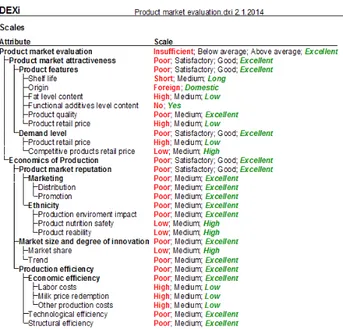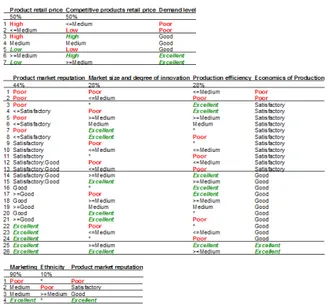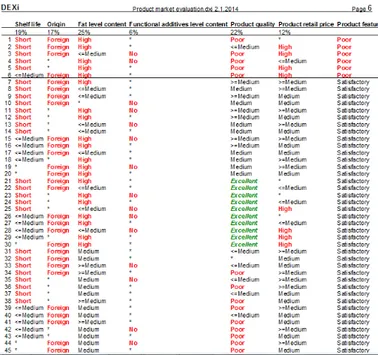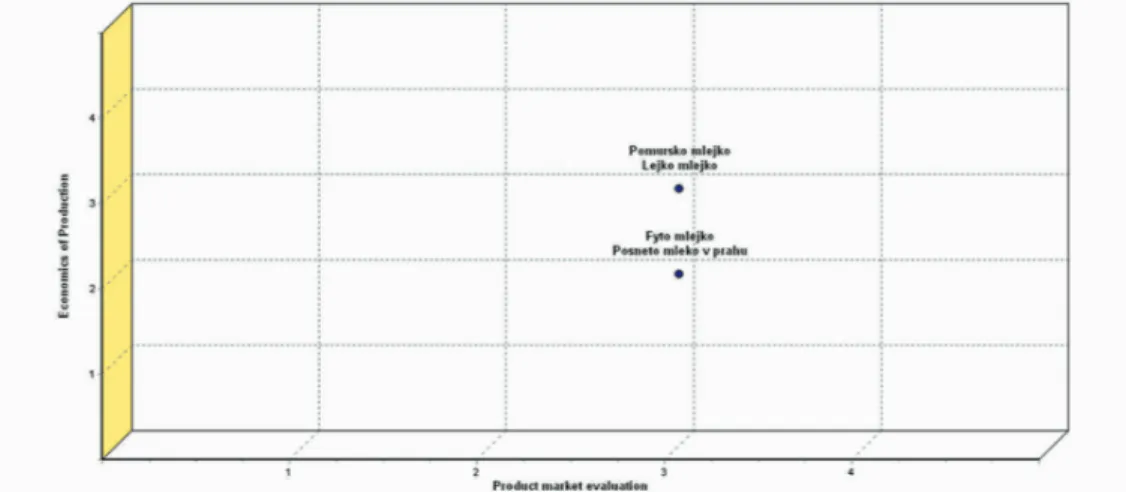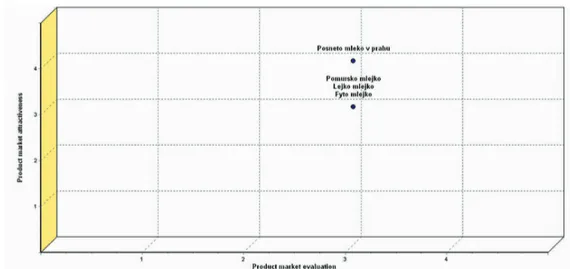*Corresponding author/Dopisni autor: Phone/Tel: +386 2 230 900; E-mail: karmen.pazek@um.si
Original scientific paper - Izvorni znanstveni rad UDK: 637.1
Multi-criteria and econometric evaluation of dairy products
Karmen Pažek*, Jernej Turk, Sebjan Hari, Črtomir Rozman, Jernej Prišenk
Department of Agricultural Economics and Rural Development, Faculty of Agriculture and Life Sciences Maribor, Pivola 10, 2311 Hoče, Slovenia
Received - Prispjelo: 17.01.2014. Accepted - Prihvaćeno: 14.04.2014.
Abstract
This study examined the multi-criteria assessment of four dairy products: “Pomursko mlejko” (Po-murje milk), “Lejko mleko” (light milk), “Fyto mleko” (Fyto milk) and “Posneto mleko v prahu” (dried milk). The research was executed by using a multi-criteria methodology, DEX, which was complement-ed by an econometric analysis for light milk to estimate the trends in production and consumption before analyzed dairy products were implemented on the market. DEXi computer program results indicated that all analyzed milk products were ‘above average’. The econometric model was applied to examine changes in the demand for low-fat milk (light milk). Empirical results showed significant consumer re-sponse to the increase in the prices of low-fat milk demonstrating income elasticity (1,15 unit).
Key words: multi-attribute decision theory, DEXi, econometric analysis, milk products
Introduction
Production and marketing strategy is vital for any modern dairy enterprise. Efficient market per-formance enables entrepreneurs involved in milk processing to effectively pursue their business activi-ties. Mura et al. (2012) explain that competition will force individual dairy companies to diversify their product range, maximize brand placement, and increase production with higher added value, espe-cially in terms of future strategy. Pažek et al. (2011) used effect size and Cohen’s-d index measures to analyze enterprises that introduced a new type of milk product (with phytoserol additives) to the mar-ket. Food economists and financial researchers have long been preoccupied by the issue of evaluating the performance of agri-food firms. In this aspect a new financial decision aid approach, which is based on data analysis techniques in combination with a multicriteria analysis method is presented by Kalo-geras et al. (2005). In many applications it is neces-sary to use a simple econometric model as the basis for decision-making process (Skouras, 2001) and its evaluation of elasticity’s that measure is used in economics to show the responsiveness (it gives the
percentage change in quantity demanded in response to a one percent change in price). However, there has been little empirical research in the dairy industry thus far on issues concerning the application of joint multi-criteria and econometric analyses for estimating market performance. Some authors (e.g. Tiwari et al., 1999) asserted that business systems are complex and market criteria alone may be insufficient. Invest-ments can be crucial to achieve product diversifica-tion, and hence, should be integrated in the planning process and decision-making strategies that are based in market opportunities too (Bojnec and Latruffe, 2011). It is important to note that multiple competi-tive criteria are likely to influence the decision-mak-ing process. A decision-makdecision-mak-ing model must be able to evaluate all options when considering factors that influence on the decisions. A multi-criteria decision analysis (MCDA) approach can be used to assess dif-ferent organizational and planning decisions. The ap-plication of MCDA in management, such as the DEX methodology employed in this paper, has been ex-tensively discussed in the literature (Bohanec et al., 2007; Bohanec et al., 2008; Pavlovič et al., 2011; Prišenk et al., 2013).
Two modelling approaches are broadly used to estimate food-demand elasticity. The first involves a simple demand analysis by using the single equation estimation approach - Engel curve is estimated first, and then subsequently food expenditure and income elasticity are derived (Shaffer, 1993). The second approach to make econometric estimations is to first construct the demand system and then compute the compensated and uncompensated (Marshallian) price and expenditure elasticity. A demand system methodology has been widely applied in empirical research through the Almost Ideal Demand System (AIDS) model. Alston and Chalfant (1993) show that an entire body of modern literature concerning food-demand analyses is exclusively based on popu-lar demand models such as the AIDS and Rotter-dam models. The ‘Linear Approximation of Almost Ideal Demand System (LA/AIDS) was employed in Slovene relations, where the demand for seven different food groups, including milk and milk products, was estimated (Erjavec et al., 1998). The authors reported that the own-price demand elastic-ity of most food products is inelastic (including for milk and milk products), while expenditure elastic-ity for milk/milk products approached 1.2, indicat-ing milk and dairy by-products to be luxury goods.
The main objective of this paper is to develop a DEXi multi-criteria decision support tool to assess four types of dairy products that are in the mar-ket implementation process in the observed agri-food business (in search of better returns, the milk industry is widening its focus to include and imple-ment new milk products on the market). Further, an econometric analysis is provided to estimate production and consumption trends for one of the analyzed dairy product based on MCDA methodol-ogy. The paper first describes the development and application of the DEXi MCDA support tool and econometric model in the Materials and Methods section. Then the results of the multi-criteria anal-ysis of the examined milk products using the DEX methodology and linear-logarithmic model are pre-sented in the Results section. Finally, the last sec-tion presents the main findings and conclusions of this study.
Materials and methods
An economic crisis might have a significant impact on the food demand, including staple food products such as dairy products. These shifts in the economic system would largely affect only the higher or lower income groups of the popula-tion. An economic crisis might have a significant impact on the food demand, including staple food products such as dairy products, although consum-ers under rather severe deteriorating economic circumstances tend to exhibit even more drastic change of their purchasing patterns - towards basic commodities only (e.g. bread, milk, potato, etc.). One of the main aims of this research is to identify a few of these effects and evaluate their influence on market performance as well as the consump-tion structure of dairy products. The multi-criteria decision methodology is used to evaluate the mar-ket performance and the demand for the analyzed milk products. Hierarchical multi-criteria deci-sion models (MCDM) are a general decideci-sion sup-port methodology aimed at the classification or evaluation of options that occur in decision-making processes (Bouyssou et al., 2006).
DEX is a combination of traditional multi-attribute decision-making processes and specific elements of expert systems and machine learning techniques (Bohanec, 2003). The variables in this method are connected by utility functions, which are adjusted to the qualitative variables and hence represented by the “if-then” decision rules (elemen-tary decision rules). They are usually arranged in a tabular form. The DEX method can be used for solving various decision problems in the real-world and is also supported by a software program called DEXi (Bohanec et al., 2000). A multi-attribute DEX model is characterized by the following (Bo-hanec, 2003):
• The model consists of variables called attributes that are structured hierarchically.
• All the attributes are qualitative rather than quantitative, with only a finite (and usually a small) number of discrete symbolic values in-cluded.
• The aggregation values of the model are defined by rules.
The hierarchical model structure was used to examine the milk product alternatives (defined as Product Market Evaluation in the hierarchical struc-ture) and was defined by a focus group consisting of experts involved in the decision-making process in concerned enterprises. First, two main criteria for the analysis were identified and incorporated into the model structure, namely, a) product mar-ket attractiveness and b) economics of production. Then, the two sets of criteria were divided into
sub-Figure 1. Hierarchical model structure for assessment of milk product alternatives
Figure 2. Basic structure of the decision model with descriptions of values
groups, and finally they were divided further in the final evaluation of the analyzed products. The hierar-chical DEXi model structure is presented in Figure 1. The attributes at the lowest level were basic de-scriptors of model alternatives such as shelf life, origin and fat level content (Figure 1). These basic descrip-tors represented model inputs, which were provided by the decision maker. Figure 2 shows discrete value sets that characterized all attributes in the model.
Figure 3 shows the decision rules in a so-called complex form with headings displaying the ap-proximate weights assigned to the attributes; the so-called ‘weight-based strategy’ of defining deci-sion rules was used. The symbols ‘< =’ and ‘> =’ defined value intervals for the relevant attribute. An asterisk in the evaluation indicated any potential value. The relative importance of the attributes was expressed by weights, as seen at the top of Figure 3. These weights were estimated by DEX by using a linear regression method (Rozman et al. (2009), where DEX interpolated the values of previously undefined rules in the table. The linear coefficients responded to the required weights, and its surface was as close as possible to the subset of rules ini-tially specified (Pavlovič et al., 2011). In practi-cal terms, the magnitude of the weight was directly proportional to the importance of the attribute. The difference between local and global weights is due to the tree of attributes. Local weights refer to a single aggregate attribute and a single correspond-ing utility function, so that the sum of weights of the attribute’s immediate descendants (function arguments) is 100 %. Global weights, on the other hand, take into account the structure of the tree and relative importance of its sub-trees. A global weight of an attribute is calculated as a product of the local weight and the global weight of the at-tribute that lies one level above. A global weight of the root attribute is 100 % (as seen in Figure 5) (DEXi, 2014).
Each attribute was first assigned a scale, and then the utility functions were defined, as shown in Figure 5. The utility functions evaluate and de-fine an individual attribute in relation to its immedi-ate descendants in the hierarchy. A utility function procedure was derived for each level in the hierar-chy; partial utility function was derived for aggregate attributes and overall utility function for the whole model except for the lowest level. DEX uses qualita-tive variables, whose values are usually represented by words rather than numbers, for example “poor”, “medium”, “excellent”, etc. Furthermore, to repre-sent and evaluate decision alternatives, DEX uses “if-then” decision rules. For instance, a decision rule can be: “if the Distribution is “excellent” or “medium” and Promotion is “poor”, then the alternative is evalu-ated as “Above average”. Further, “if the Distribution and Promotion are “poor”, the alternative is evaluated as “Below average” This is in contrast with more com-mon quantitative MCDA, which use utility functions that employ weights, such as the expected value or weighted sum. Average weights for final Product mar-ket evaluation are presented in next figure (Figure 4).
The first part of the example illustrating the de-cision rules for the observed problem is presented in Figure 5. The decision rules, which are acquired from the model developer describe the mapping of the two main attributes, five sub-attributes and oth-er sub-sub attributes as well as the final cumulative attribute assessment into the overall product market evaluation (as seen in Figure 2). Complex rules are Figure 3. Examples of some decision rules with utility function for presented case
obtained by joining several elementary rules which have the same function value.
Further an econometric analysis of observed dairy production was provided. One objective of this empirical study was to evaluate the genuine response of low-fat milk consumers to price changes as well as yogurt prices. It also aimed to predict consumer reactions to changes in consumer income (average net salaries). The model specification was derived by including an endogenous variable (demand for low-fat milk) and three exogenous variables (price of low-fat milk, price of yogurt and average net salary in Slovenia). The data collected from the Statistical Office of Republic of Slovenia (2011) was for the period 2000-2008. The data were also deflated by the Wholesale Price Index (WPI). The applicability of the data series is a key element in conducting sin-gle equation estimation (evident in cases requiring a sophisticated system demand approach), especially if certain discrepancies in the official statistical data may have occurred. This suggests that any
econo-metric analysis will be difficult to perform without proper data sets that is presented in Table 1.
The linear-logarithmic (lin-log) model yielded the most reliable empirical results and was sup-ported by corresponding statistical tests and reliable econometric validation:
y1 = lnα + βlnx1 + γlnx2 + δlnx3 + ut
where: y1 = demand for low-fat milk, α = intercept, β,γ,δ = parameter estimates, x1 = price of low-fat milk, x2 = average net salary, x3 = price of yogurt, ut = random residual.
Results and discussion
The milk product alternatives that were ana-lysed by the multi-criteria decision theory were “Pomursko mlejko” (Pomurje milk), “Lejko mleko” (light milk), “Fyto mleko” (Fyto milk) and “Pos-neto mleko v prahu” (dried milk). The input data for the DEXi model analysis were gathered by the enterprise’s focus group. The data comprised two
Figure 4. DEXi model structure with average weights
Parameter/year 2000 2001 2002 2003 2004 2005 2006 2007 2008 y1 ( €) 15,35 15,92 18,85 21,44 24,58 26,05 27,98 28,99 28,98 x1 (€ for 1) 0,65 0,69 0,72 0,71 0,71 0,69 0,68 0,76 0,95
x2 (€) 503,50 562,60 617,30 663,70 693,00 736,00 773,20 834,20 899,60 x3 (€ for kg) 1,65 1,69 1,83 1,88 1,86 1,83 1,92 2,14 2,58 Table 1. Input data aid for econometric empirical analysis
aggregate attributes by the utility function, and an integrated assessment of a particular milk product was determined, as seen in Figure 6.
We concluded from the results in Figure 6 that the main issue facing the concerned enterprise is the implementation of the product to the market and its productivity and commercial success. As seen in Fig-ure 6, all business alternatives were ranked above av-erage. On the one hand, “Pomursko mlejko” (Pomur-je milk) and “Lejko ml(Pomur-jeko” (Light milk) were found to be efficiently manufactured and easily marketable,
Figure 6. Integrated final assessment of single milk product business alternatives Figure 5. Defined decision rules with utility functions for presented case
while on the other, “Posneto mleko v prahu” (dried milk) was found to have excellent market attractive-ness but only satisfactory production efficiency. “Fyto mlejko” (Fyto milk) was ranked slightly lower, with good market attractiveness and satisfactory econom-ics of production. However, to improve the final eval-uation of each business alternative, a detailed analy-sis of the decision model was conducted. As seen in Figure 7, with regard to the criterion economics of production, the enterprise showed rather uniform production.
A detailed model analysis showed that “Posneto mleko v prahu” and “Fyto mlejko” were inferior to the other two alternatives, due to a lack of size and degree of innovation and low market share. The conclusion, based on the model results, was that the enterprise has homogeneous economic efficiency in dairy pro-duction. This means that the structural, technologi-cal and economic effectiveness for all analyzed dairy products was the same, namely, “medium”.
When considering the attribute of ethnicity, factors such as the environmental impact, safety and reliability of the product were considered. All these three sub-attributes received the highest rating be-cause no allergies have been reported and the prod-ucts have no additives or features that could have a negative impact on consumer health or the environ-ment, i.e., product packaging.
In the marketing sub-attribute, we considered the effectiveness of product promotion and distri-bution. The enterprise jointly promotes its products instead of advertising individual or groups of prod-ucts (e.g., Pomurje milk and yoghurt). Moreover, its promotional campaign performance is significantly lower than that of its competitors. Therefore, the promotional campaign of the analyzed dairy prod-ucts was considered to be “bad”. The distribution of the first three milk products was marked as ‘ex-cellent’ as the enterprise distributes these products in three major Slovene trading enterprises. The dis-tribution of the fourth milk product is, however, limited to the largest shopping centers in Slovenia (in the model marked as “medium”).
The concept of “product market attractive-ness” focuses on the factors related to customer perception (Figure 8). Consumer trends show a declining interest in the fat content of milk due to health concerns and increased use of milk protein and various functional additives (omega-3 fatty ac-ids, coenzyme Q10, plant sterols, etc.). Therefore, following the evolution of consumer preferences, habits and competitive products, milk products 2, 3 and 4 were assessed as “trendy”.
“Posneto mleko v prahu” received the highest score of 4 for product market attractiveness, while the other three analyzed milk products were as-sessed as “good”. However, as seen in Figure 8, the analyzed milk product “Posneto mleko v prahu”, with the highest level of marketing attractiveness, was deemed “satisfactory” in the attribute econom-ics of production. Therefore, a challenge for the en-terprise is that customers are attracted to a product that has higher economics of production over simi-lar products with lower economics of production.
With regard to the demand level attribute, the products were evaluated using market research based on price comparisons between own products and mutu-al comparisons between own and competitor products. In the mutual comparison, the retail price was lower for “Lejko mlejko”. The attribute “product features” was defined on the basis of the results of surveys on the de-mand for milk from the enterprise (336 surveys). Ac-cording to these results, “Posneto mleko v prahu” was assessed as “excellent” because of its high quality, long shelf-life and especially its low fat content (defined as
Figure 7. Economics of production alternatives ranking
*Economics of Production: 1 - poor, 2 - satisfactory, 3 - good, 4 - excellent; Product market evaluation: 1 - insufficient, 2 - below average, 3 - above average, 4 - excellent
the factor that most influences the market attrac-tiveness of the product). The other three products were deemed “good”. According to the results is the model sufficiently sensitive to generate other sce-nario analysis.
A compiled data set also allowed us to con-duct econometric analysis on the demand for low-fat milk. Because of the existing constraints in data availability, individual equation estimation was per-formed instead of the complex system of the de-mand approach. The model evaluation referring to economic, statistical and econometric criteria sug-gested that the lin-log functional form estimation was the best empirically supported single-equation model. Hence, empirical application is not very chal-lenging to execute, and the results are simple enough to be interpreted with relative ease. The economet-ric analysis provided a proper empieconomet-rical framework to investigate the basic demand trends and enabled the computation of own price, cross price and in-come demand elasticities as seen in Figure 9:
The single equation was developed to demon-strate the change in demand for low-fat milk. A specified equation for low-fat milk demand was estimated by using the OLS method. Econometric estimates are well supported with statistical tests (t-test, R2), while Durbin Watson (D.W.) shows that
there is no problem of autocorrelation. Hence, the empirical results derived refer to own price, cross price and income elasticity. The demand for low-fat milk was found to be price elastic, indicating relatively high responsiveness of consumers to price alterations. The results showed that an increase in low-fat milk prices led to a decline in its demand by 1.15 %. This indicated a price elastic response on the part of consumers, which aligns with the study by Haidacher et al. (1988). It is evident that an increase in average net salaries, as well as a rise in yoghurt prices, boosts the demand for low-fat milk. While the range of income elasticity (1.24) indicat-ed that low-fat milk could be perceivindicat-ed as a luxury good, the positive sign of the cross price elasticity Figure 8. Assessment of product market attractiveness of analyzed milk products
Figure 9. Model summary output for dependent variable “demand for low-fat milk” ŷ = -184 – 26.61 lnx1 + 28.71 lnx2 + 16.96 lnx3 R2 = 0.97 D.W. = 1.96
*Product market attractiveness: 1 - poor, 2 - satisfactory, 3 - good, 4 - excellent; Product market evaluation: 1 - insufficient, 2 - be-low average, 3 - above average, 4 - excellent
value (0.73) denoted that low-fat milk and yogurt were considered important for subsistence.
The increase in demand for low-fat milk indi-cated that its consumption has become more re-sponsive to price changes. The cross price elasticity estimate was inelastic but established a strong link between the demand for low-fat milk and yoghurt. Yoghurt and low-fat milk have become increasingly price elastic indicating that they are viewed as im-portant for subsistence. The high value of income elasticity revealed consumer behavioral patterns suggesting that low-fat milk is considered as a lux-ury good in Slovene regions. The latter result cor-roborates the empirical derivations of Erjavec et al. (1998), who also obtained similar values of demand-expenditure elasticity for milk.
Conclusions
This research uses two approaches, namely, a) the multi-criteria approach and b) the economet-ric approach, in order to exploit a limited data set and analyze the price elasticity of four dairy prod-ucts. The developed multi-attribute DEXi model can be regarded and applied practically to a broader sphere of dairy production enterprises. The model can be applied to similar new dairy’s product evalu-ation, however if necessary appropriate changes in the hierarchy and decision rules should be made with respect to producers or product specifics’. This kind of model is comprehensible to a wide range of users in the evaluation process. It can be used in business planning and strategic enterprise de-velopments. The model features such as sensitiv-ity analysis and visualization, which contribute to the comprehensibility and justification of the assessment process, and may also give spe-cific advice to the management and product de-velopers on how to improve market acceptance of the new dairy product. In addition, it can be upgraded with the latest information and adapt-ed to specific requirements. The multi-criteria methodology cannot replace or exclude the man-agement or decision-making experts, but it can be a tool to conduct efficient analyses. Further, a simple econometric analysis was designed to provide empirically supported indices to make coherent policy recommendations. The own-price demand elasticity for low-fat milk shows that consumers
would respond strongly to changes in its prices, while the cross-price elasticity value infers substitutes between low-fat milk and yoghurt. The most striking result probably comes from the relatively high value of income demand elasticity for low-fat milk. This can be explained by changes of consump-tion habits (diet) as well as the lower purchasing power of many domestic consumers who are seeking new ‘popular’ food commodities. Milk consumption is high in Slovenia and the consumers are sensitive to changes in their economic environment. These find-ings are compelling, especially if applied to other dairy and food products.
Višekriterijski i ekonometrijski
pristup ocjenjivanja mliječnih
proizvoda
Sažetak
Multikriterijski pristup ocjenjivanja mliječnih proizvoda u smislu upotrebe DEX bio je na-dograđen ekonometrijskom analizom za ocjenjivan-je proizvodnih i potrošačkih trendova priocjenjivan-je negoli su analizirani proizvodi uvršteni u prodaju. Studija istražuje četiri različita mliječna proizvoda odnos-no proizvodne alternative: “Pomursko mlejko”, “Lejko mleko”, “Fyto mleko” i “Posneto mleko v prahu”. Rezultati DEXi analize ukazuju na to da se svi analizirani mliječni proizvodi svrstavaju u ka-tegoriju “iznadprosječni”. Istraživana je mogućnost poboljšanja situacije s mlijekom u prahu preko po-većanja njegove distribucijske moći na tržištu, te je pri tome upotrijebljena “what-if‘” (“što-ako”) analiza. U zadnjoj fazi izgrađen je ekonometrijski model za ocjenjivanje promjena u strukturi potra-živanja mlijeka s malim postotkom masnoće. Em-pirijski rezultati pokazali su veliku reakciju kupaca na promjene u cijenama te vrste mlijeka, s relativ-no visokim vrijedrelativ-nostima elastičrelativ-nosti potraživanja (1,15 jedinice).
Ključne riječi: multikriterijska teorija odlučivanja, DEXi,
Acknowledgements
We express our grateful thanks to both anonymous reviewer and editor for the useful sugge-stion to improve the paper. Further, we also thanks to the “Pomurske mlekarne d.d” for providing data for this research.
References
1. Alston, J.M., Chalfant, J.A. (1993): The silence of the lambdas: A test of the Almost Ideal and Rotterdam mod-els. American Journal of Agricultural Economics 75 (2), 304-313.
2. Bohanec, M. (2003): Decision Support, In Mladenić, D., Lavrac, N., Bohanec, M., Moyle, S. (Eds.), Data Mining and Decision Support, Academic Publishers, London 3. Bohanec, M., Cortet, J., Griffiths, B., Žnidaršič, M.,
De-beljak, M., Caul, S., Thompson, J., Krogh, P.H. (2007): A qualitative multi-attribute model for assessing the im-pact of cropping systems on soil quality. Pedobiologia 3 (15), 239-250.
4. Bohanec, M., Messean, A., Scatasta, S., Angevin, F., Griffiths, B., Henning-Krogh, P., Žnidaršič, M., Džeroski, S. (2008): A qualitative multi-attribute model for eco-nomic and ecological assessment of genetically modified crops. Ecological Modelling 215 (1-3), 247-261. 5. Bohanec, M., Zupan, B., Rajkovič, V. (2000):
Applica-tions of qualitative multi-attribute decision models in health care. International Journal of Medical Informatics 58-59, 191-205.
6. Bojnec, S., Latruffe, L. (2011): Financial availability and investment decisions of Slovenian farm during the transi-tion to a market economy. Journal of Applied Economics XIV (2), 297-317.
7. Bouyssou, D., Marchant, T., Pirlot, M., Tsoukiàs, A., Vincke, P. (2006): Evaluation and decision models with multiple criteria: Stepping stones for the analyst, Interna-tional Series in Operations Research and Management Science, Boston.
8. DEXi. A Program for Multi-Attribute Decision Making, Version 4.00. (2014): (http://www-ai.ijs.si/MarkoBo-hanec/dexi.html) (3.2.2014).
9. Erjavec, E., Mergos, G.J., Mizzi, L., Turk, J. (1998): Food demand in Slovenia. Die Bodenkultur 49 (4), 273-279. 10. Haidacher, R.C., Blaylock, J., Myers, L.H. (1988):
Con-sumer Demand for Dairy Products. Agricultural econom-ic report 586, 61-63. Available at: http://naldc.nal.usda. gov/download/CAT88893757/PDF (12.12.2013). 11. Kalogeras, N., Baourakis, G., Zopounidis, C.,Van Dijk,
G. (2005): Evaluating the financial performance of agri-food firms: a multicriteria decision-aid approach. Journal of Food Engineering 70 (3), 365-371.
12. Mura, L., Buleca, J., Zeleňáková, L., Qineti, A., Kozelová, D. (2012): An analysis of selected aspects of interna-tional business in Slovak dairies in the EU framework. Mljekarstvo 62 (3), 219-226.
13. Pažek, K., Rozman, Č., Turk, J., Majkovič, D., Sebjan, H., Kolenko, M., Pamič, S., Prišenk, J. (2011): Effect size measurement in functional milk product marketing. Mljekarstvo 61 (4), 341-347.
14. Pavlovič, M., Černeak, A., Pavlovič, V., Rozman, Č., Pažek, K., Bohanec, M. (2011): Development of DEX-HOP multi-attribute decision model for preliminary hop hybrids assessment. Computers and Electronics in Agri-culture 75 (1), 181-189.
15. Prišenk, J., Rozman, Č., Pažek, K., Turk, J., Bohak, Z., Borec, A. (2013): A multi-criteria assessment of the production and marketing system of local mountain food, Renewable Agriculture and Food Systems. Avail-able at: http://journals.cambridge.org/action/displayA bstract;jsessionid=75EDEB3BD18DE3BC35507275 8940DC86.journals?fromPage=online&aid=8943659 (15.11.2013).
16. Rozman Č., Potočnik, M., Pažek, K., Borec, A., Majkovič, D., Bohanec. M. (2009): A multi-criteria assessment of tourist farm service quality. Tourism Management 30 (5), 629-637.
17. Shaffer, C.V. (1993): An Analysis of Consumption and Expenditures for Lithuanian Households Using Budget Survey Data, Center for Agricultural and Rural Develop-ment, Iowa State University. Available at: http://www. card.iastate.edu/publications/DBS/PDFFiles/93br8.pdf (6.12.2013).
18. Skouras, S. (2001). Decisionmetrics: A decision-based approach to econometric modelling. Available at: http:// citeseerx.ist.psu.edu/viewdoc/download?doi=10.1.1.19 5.5813&rep=rep1&type=pdf (14.1.2014).
19. Statistical Office of the Republic of Slovenia. (2011): Statistical Yearbook 2011, Ljubljana. Available at: http://www.stat.si/eng/novica_prikazi.aspx?id=4397 (26.11.2013).
20. Tiwari, D.N., Loof, R., Paudyal, G.N. (1999): Environ-mental-economic decision-making in lowland irrigated agriculture using multi-criteria analysis techniques. Ag-ricultural Systems 60 (2), 99-112.
